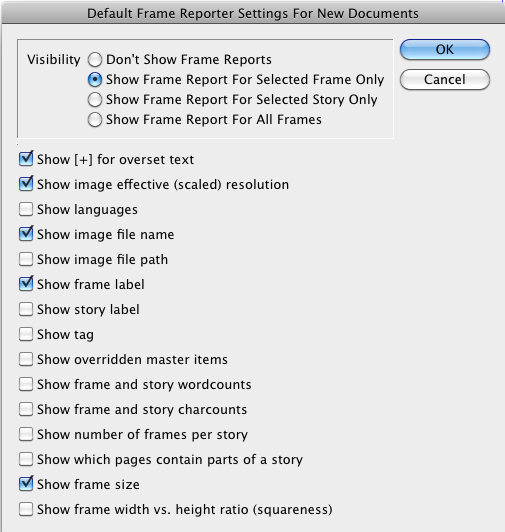Avoid digging through scattered InDesign palettes for info – this tool displays important information about your InDesign document right were you need it, in your work area. No need to disrupt your train of work and move your mouse all over the place to bring some palette or indicator into view.
A small sample of what it does: look at the four frames shown here: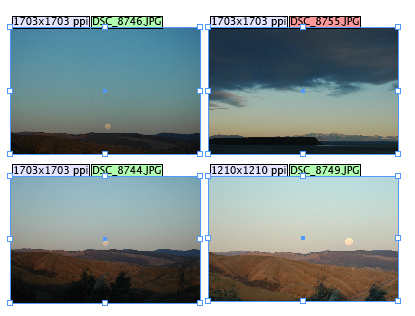
Imagine you’ve been asked to place a whole lot of images, and it’s really important that the images are placed on the pages in alphabetical order of their file name. The problem is that the images look very similar, and carry similar names – how do you quickly verify you’ve placed them correctly? Furthermore, all images should be placed at the exact same scaling factor, so their effective resolution is the same. Again, how do you quickly find that out if there are any out-liers?
Look at the four selected image frames shown above: we can immediately see that
- DSC_8755 is out of order
- DSC_8755 has a broken link (hence a red background behind the name)
- DSC_8749 has been scaled to a different effective resolution than the other three
Of course, there is more – FrameReporter can display the following information in little info-labels right next to individual page items:
- A much improved overset text warning
- Effective resolution
- Name of the placed image
- Path of the placed image
- Name of the currently selected story
- Name of the currently selected page item
- Number of words in frame compared to total number of words in story
- Position of text frame within a multi-frame story
- Roadmap of all pages containing parts of a multi-frame story
- Whether an item is overridden from the master page
- Squareness of frame.
FrameReporter also adds new navigation features to InDesign – you can ‘jump to’ named stories or named frames.
See further (‘Examples’) for a more extensive description and samples of each of these features.
The preferences dialog shows the current range of available options:
We’re always looking for suggestions for other interesting information snippets that we could add – feel free to e-mail us at [email protected].
Installing
Before you start installing, exit out of InDesign.
To install, you will need to add three items (four for Windows CS5) to your InDesign plug-ins folder.
The FrameReporter download contain separate Windows and Macintosh versions – make sure to decompress and open the proper version for your computer.
You need to install the proper version of APID ToolAssistant – there are a fair number of different versions provided (Mac/Win/CS/CS2/CS3/CS4/CS5) and you need to make sure to pick the proper one. Move this plug-in into the InDesign Plug-Ins folder (or a subfolder thereof).
FrameReporter will continue to work when the APID ToolAssistant demo expires.
i.e You do NOT need to purchase an additional license for APID ToolAssistant.
Second, you need to copy both the FrameReporter.spln and the FrameReporterLib.spln into your plug-ins folder as well.
Restart InDesign, and open or create a document.
You can convert this demo version into a full version at any point in time. When you start InDesign, you should see a ‘beg’-dialog for FrameReporter – click the Get License… button and you’ll be directed to a web page for purchasing the license or for using the Activation Code.
Alternatively, you can select the API – APID ToolAssistant… menu item, select the line for FrameReporter, and click Get License…
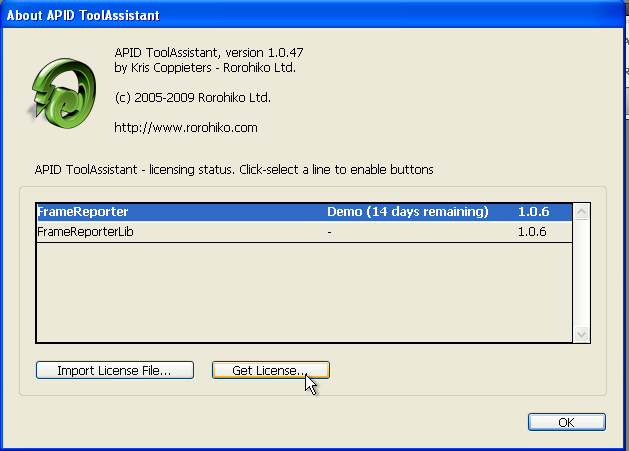
Usage
This plug-in can add a little ‘info label’ to any currently selected page item(s).
After installing and launching InDesign, first open or create a document (important!).
Then select the API – FrameReporter – Default Preferences… or the API – FrameReporter – Current Document Preferences… menu item to configure things to your liking.
Important remark: if the ‘info label’ has too much information, and becomes too wide, it will be suppressed. For example, the image file path name is often very long, and cannot ‘fit’ alongside the page item – and then it will be suppressed.
When that happens, you need to zoom in using the InDesign zoom tool (the magnifying glass): the deeper you zoom, the wider the page item will be – and eventually the info-label will ‘fit’.
The current version has the following features:
• For stories spanning multiple text frames, you’ll be able to see whether the story has overset text in the last text frame at the end – so when you’re clearing up an overset in a 20-frame story by editing a frame towards the start of the story, you can immediately see whether the overset is fixed without needing to scroll all the way to the end.
The ‘overset text warning’ is purposely slightly different from InDesign’s built-in overset text indication: FrameReporter also warns in the case where the overset text consists purely of white space characters.
• You can see the effective resolution of bitmap images (i.e. the resolution which combines the images’ native resolution and any scaling that might have been applied to it).
• You can see a list of languages used for hyphenation/spelling in a story.
• You can see the image file name or image file path for a placed image.
• You can see when a page item is an overridden master page item.
• Stories can be assigned a name; for example, you could assign the name of the author to the story, or a short description of the content (e.g. ‘product info’, ‘contact us’), or anything else you like.Assigning a name to a story is achieved by clicking a text frame with the regular selection cursor, and then selecting API – FrameReporter – Story Label…
FrameReporter can be configured to display the story name just below the bottom of the currently selected text frame.If a story has been assigned a name, you can use FrameReporter to quickly ‘jump’ to the named story. This is handy in complex documents, with many stories.
• InDesign has a standard feature that allows you to assign a name, a.k.a ‘script label’ to a page item (via the Windows – Automation – Script Label palette).
FrameReporter will display the frame name just below the bottom of the currently selected frame.
If a frame has been assigned a name, you can use FrameReporter to quickly ‘jump’ to the named frame. This is handy in complex documents, with many frames.
• You can see the relative position of a frame in the story.
• You can see what pages contain one of more text frames that are of the story.
• You can see the ‘squareness’ of any selected page item; the plug-in divides the shorter side by the longer side of any selected frame, and expresses that as a percentage:
- Square frames have a squareness of 100%. The longer and narrower a frame is, the lower the squareness.
- A squareness of 62% corresponds to the ‘golden ratio’ – so for visually pleasing rectangles, you could aim for roughly 62% squareness.
For a more in-depth discussion of these options, please click here.
Examples
Overset text warning
InDesign is quite laid back when it comes to text that is overset. The only visual indication you get is that the last text frame of the story shows a red plus sign in the out port.
Enter FrameReporter. For stories with overset text it will add a visual indicator to any frame of the story – whether that frame is at the beginning, in the middle or at the end of the text story.
That’s very handy if you’re trying to fix overset text by removing some words from the text: you can be editing frame 9 of a 100-frame story, and you’d immediately know that the overset has been fixed when the indicator disappears.
An example: imagine that the four text frames you see are actually spread out over four pages (instead of sitting on a single page – I’ve done that to make it easier to explain things).
There’s overset text, and I am going to clean up the text in the second frame of the four-frame story.
I selected the second text frame. The little [+] in the reddish indicator near the out connector of the selected text frame indicates that the story has overset text:
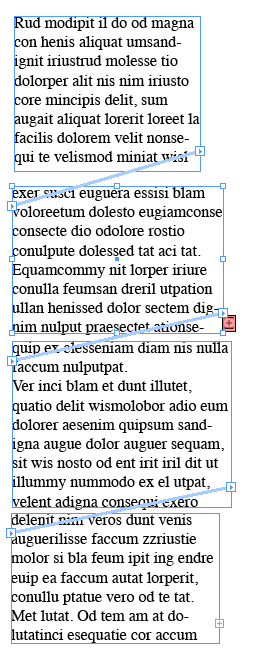
I now select some words that I want to delete from the frame:
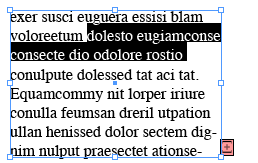 Hit the ‘Delete’ key to shorten the text – and the overset warning disappears. No need to go check the last frame of the story!
Hit the ‘Delete’ key to shorten the text – and the overset warning disappears. No need to go check the last frame of the story!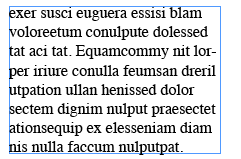
Named Stories and Named Frames
Select the API – FrameReporter – Current Document Preferences… menu item and make sure the two options Show Frame Label and Show Story Label are selected:
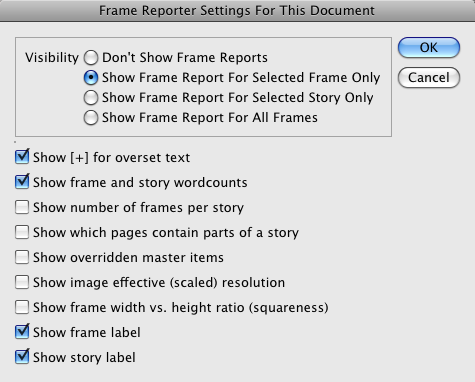
Create a document with a two multi-frame stories (create two sets of text frames, and thread each set together).
Select any frame in one of the two threaded sets and select the API – FrameReporter – Story Label… menu item:
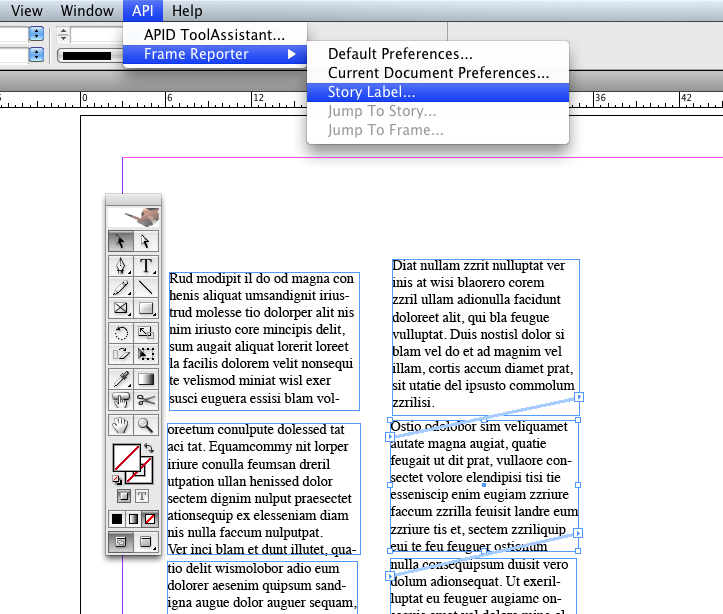
Enter a Story Label (for example ‘Silly Story’):
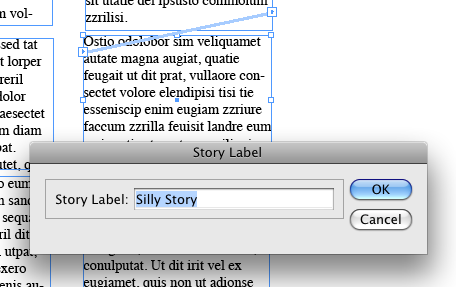
Do the same with the second set of frames – name that one ‘Stupid Story’.
Each time you select any frame of either story, you will see the name of the story displayed in the little green info-label underneath the selected frame:
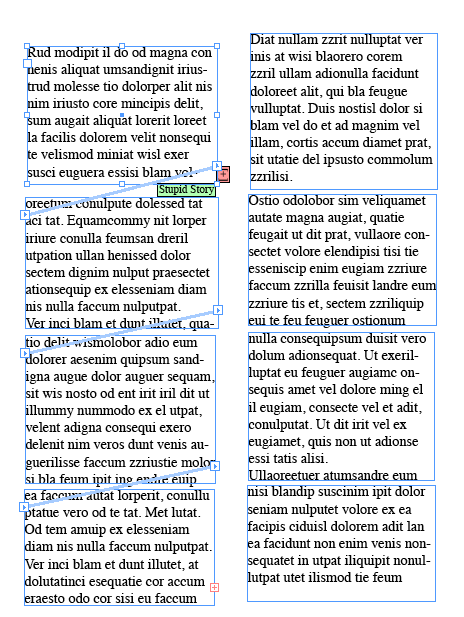 You can also name the individual frames. Display the Script Label palette by selecting the Window – Automation – Script Label or (for InDesign CS) Window – Scripting – Script Label menu item.
You can also name the individual frames. Display the Script Label palette by selecting the Window – Automation – Script Label or (for InDesign CS) Window – Scripting – Script Label menu item.
Select a frame, and type a name for it into the script label – I’ve selected the last frame of the stupid story.

IMPORTANT: After typing the label, click in an empty spot on the page (the script label palette is a bit odd, and unless you handle it properly, the label won’t take. Clicking in an empty spot on the page makes it ‘take’).
Re-select the frame – in addition to the green info-tag with the story name, it will now also display a yellow info-tag with the frame name.
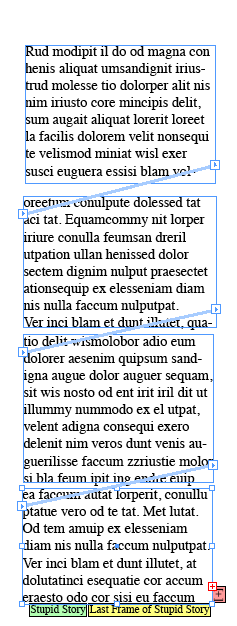
Now you can also use the API – FrameReporter – Jump To Story… or API – FrameReporter – Jump To Frame… menu items to quickly jump to a particular named story, or a particular named frame:
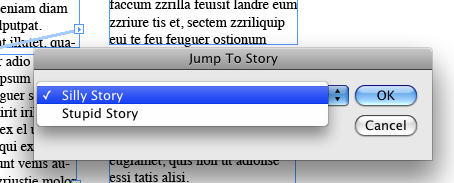
This can help when navigating a big, complex, multi-story document.
Show Frame and Story Wordcounts
This option of FrameReporter is handy when you’re aiming for a particular word count. As you’re editing the story, you are continuously informed about the total number of words in the story, as well as the number of words in the current text frame.

In the sample screen capture, I have 79 words in the current frame, out of a total of 242 words in the whole story.
These word counts are dynamic. As we all know ;-^ , ‘nseque’ is preferrably spelled as two words, so let’s split up ‘nseque’ into ‘nse que’ by adding a space character:
 Note that the word counts have automatically updated to 80 and 243!
Note that the word counts have automatically updated to 80 and 243!
Show Number of Frames Per Story
With this option, it becomes easy to know your position along a story – it helps you navigate the story.
 In this example, the complete story runs through four frames, and the currently selected frame is the third of these four.
In this example, the complete story runs through four frames, and the currently selected frame is the third of these four.
Overridden Master Page Items
Another thing that’s hard to see in InDesign are overridden master page items.
Master page items showing through on a document’s pages are easily recognizable because their frame is drawn with a dotted line.
But once a master page item is overridden, there is no simple way to tell that the item is a master page item. Still, overridden master page items behave slightly different to normal page items.
Check the following screen shot:

The bottommost, cyan page item is an overridden version of the cyan item on master A. I’ve repositioned it to make it clear it’s overridden, but it still retains some relation to the original item that sits on master A.
If I change the color of the cyan item on master A to green, this is what happens:

Now, let’s switch on FrameReporter and select both frames:

Now it is easy to see that the green item is actually an overridden master page item.
Show Image Effective (Scaled) Resolution
This information is identical to the resolution info that is provided on the Info palette. The main advantage of this feature becomes apparent when you want to check the effective resolution of a whole lot of images.
Instead of selecting them one by one and looking at the info palette, I can simply select all of them, and see their resolutions all at the same time.
In this example screen shot I have selected two placed images. You can see that the Info palette does not show any resolution info – it cannot handle multiple selections.

Squareness
This feature gives you an idea of how far from or how close to square a particular frame is.
A value of 100% is completely square, anything less than 100% is a rectangle – it does not matter whether the rectangle is in portrait or landscape orientation.
Check the following screen shot:
 You can see that the two ‘squares’ are not completely square because they have a squareness below 100%.
You can see that the two ‘squares’ are not completely square because they have a squareness below 100%.
The two rectangles are both ‘golden ratio’ rectangles – which are considered the most ‘balanced’ and visually pleasing kind of rectangle by many – 62% is the squareness of a ‘golden ratio’ rectangle.
Show Which Pages Contain Parts Of A Story
This is a slightly more complex information – it is essentially a roadmap for the current story. Check the following screen shot:

I can tell that the currently selected frame is part of a multi-frame story.
Let’s first ignore the (3), the number between parenthesis; we’ll get to that later.
Before passing through the current selected frame, the story appears in text frames that live on page 1 and 2 (Pgs. before: 1,2)
After passing through the selected frame, the story appears in a text frame on page 6 (Pgs. after: 6).
Furthermore, on page 1, I can also see that the story goes through three text frames – 1(3) means: on page 1 occurring 3 times. That’s what numbers between parenthesis are about: they show you when there are multiple linked text frames for the same story on a single page.
As you can see, this FrameReporter option allows me to see a whole roadmap for the story in the blink of an eye!
Configuration
All of the options shown above can be activated or deactivated as desired through the API – FrameReporter – Current Document Preferences… menu item.
You can select multiple options – all the selected options will be shown concurrently by FrameReporter.
Changing these options will only affect the current document – each document carries its own FrameReporter settings.
There is also the FrameReporter – Default Preferences… menu item which allows you to set up the default preferences to use when no preferences have been chosen for a particular document.
